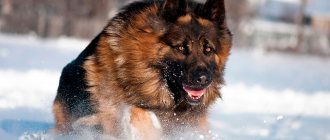Walking the dog is one of the worries that arises after a puppy appears in the house. In principle, this daily ritual is extremely necessary for the dog. Moreover, she needs him not only to fulfill her natural needs. But also to obtain the physical activity necessary for a normal life.
But for a walk to have the desired effect, it is not enough to simply attach a leash and take your dog outside. The walk must be properly organized. Moreover, it is necessary to ensure the ability to control the behavior of your pet.
Rules for walking dogs in the city - law and etiquette standards
Unfortunately, the culture of behavior in society, including among dog owners, is developed at a fairly low level.
In fact, no laws will stop a person from unwanted behavior, which is why there are administrative and criminal codes, lawyers, prosecutors and other “branches” of the justice system. The rules for walking dogs in the city are the law and norms of etiquette, and the second part has a higher significance.
Almost all “dog people” love their pets madly, consider them the smartest, most beautiful... and demand that society accept this opinion.
In fact, not one person in your circle is obligated to love your dog. Moreover, some people are afraid of dogs and cannot control this phobia.
Walking a dog on a leash is a law, a norm of etiquette and concern for the safety of the pet. Walking dogs without a leash is allowed only in designated areas, and as you know, walking areas exist only in large cities and in very limited quantities.
No one says that you have to walk your dog only on a leash, but if you let your pet out, make sure that you are in a place away from people and your pet will not scare anyone.
Important! A leash is a guarantee that your pet will not run out onto the road, chase the cat, or get lost.
Walking with a muzzle is a measure that most dog owners protest against, but it is the law.
If you are in a public place, your dog must be muzzled - this is not discussed, even if your pet is below knee height or is a toy breed. People who are afraid of dogs feel calmer and more confident if your pet is muzzled.
When going to the place of walking and returning home, it is advisable to keep the dog in a muzzle, especially during the period of heat. On the way, your pet may meet a competitor or an unfamiliar dog, so a fight can happen even on a leash. Naturally, you should not allow situations where your muzzled dog is attacked by another dog.
Note! Walking with a muzzle for the safety of your pet is important until you have taught the dog not to pick up leftover food from the ground.
Cleaning up after your dog. The trend obliging people to clean up pet feces comes from Europe and America. The need for these laws is due to the fact that in developed countries and cities with apartment buildings there are practically no lawns, and dogs have to defecate on the asphalt surface.
If the pet went to the toilet in a place where people can walk, you need to clean up after her. While trying to comply with the law and etiquette, do not forget about preserving the environment. Do not clean up dog feces using plastic bags. For this purpose, it is better to use paper bags or napkins.
Why doesn't a dog like a leash?
Naturally, all pets disapprove of restrictions on their will, but most dogs put up with temporary inconveniences - training, walks in crowded places. Do you have a dog living in your house who panics at the sight of ammunition? There may be several reasons for this:
- Long-term chain housing develops the dog’s “everyday bondage” reflex. This is a psychological trauma in which the animal is afraid not only of the leash, but also of the collar.
- Long or forced wearing of a muzzle develops a sharply negative attitude of the pet towards any equipment.
- The dog was beaten with a leash - a common mistake when raising animals. You can't hit four-legged animals at all, but hitting them with a leash is a special case. A leash is the pet’s property, its means of contact with the owner, and here pain comes from such a positive object! If you don't know the dog's background and are having trouble putting the leash on, grab the ends of the leash and slap the loop across your palm. The dog will sit down, lower its ears, or run away if it is afraid of him.
- The collar is tightened too tightly or the collar is chosen incorrectly - in the first case, the dog experiences severe suffocation when pulling on the leash, in the second, it is injured.
- The dog is allowed to play with the leash or bite it while walking.
Note! Under the fastened collar, 2 fingers should fit freely at any angle.
Duration of walks with the dog
The duration of walks with your dog directly depends on its age and temperament. The younger the puppy, the more often he needs to be walked because he cannot control the urge to urinate and defecate.
Adult dogs are walked 2-3 times a day. One of the walks should last at least an hour, and the dog should have the opportunity to run and play.
Long walks (more than an hour) are welcome, especially if the pet has the opportunity to communicate with its relatives. A reduction in walks may be due to weather conditions, the age and health of the pet.
Note! A short walk, allowing only to relieve the need, is relevant until the puppy has received basic vaccination.
How to teach walking on a leash and collar
Proper behavior on a leash can be taught to a dog at any age. The easiest way to raise a puppy. Training an adult requires more time, patience, and has its own nuances and tricks.
After the puppy learns to ignore the collar, the owner should begin teaching him to walk on a leash. In the first couple of days, experienced dog handlers advise only to fasten the leash to a harness or collar. The puppy needs to be called, stroked on the head, and the equipment discreetly fastened on. After several such repetitions, the animal will calmly relate to this manipulation. When the puppy gets used to the sound of the carabiner being fastened, training can continue.
Experienced dog handlers often resort to training leash tactics. For this purpose, a rope no more than 2 meters long is attached to the collar.
The lesson should be carried out in an open and safe place so that the pet cannot hurt itself or run away. The puppy is given freedom - the training leash drags along the ground. This technique allows the dog to get used to the accessory and allows the owner to control unwanted behavior and limit movement by stepping on the free end of the rope.
Once your puppy gets used to the training device, he will not be afraid of the leash.
Positive dynamics in learning must be reinforced with treats. If the puppy does not understand at first what is required of him, he should return to training from the previous stage. Under no circumstances should you shout at the dog or sharply pull the leash. This behavior will reduce positive motivation and prolong the adaptation time.
When should you feed your dog - before or after a walk?
Many owners don't know when to feed their dog - before or after a walk? Logically, the dog needs to be fed before the walk so that it can go to the toilet. In fact, this technique is only used with puppies whose break between eating and relieving themselves is 20–30 minutes.
Adult dogs are fed strictly on a schedule and only after a walk.
Physical activity immediately after eating is dangerous because it can lead to volvulus. Volvulus is a life-threatening condition that can only be corrected through surgery.
Morning and evening walks - features and differences
Let's look at the standard pattern of morning and evening walks with the dog, let's name the important features and differences:
- A quick morning walk - the dog is taken outside for 10-15 minutes, after which the owner goes to work.
- Evening walk – a long walk.
If your dog is an adult and is accustomed to walking, the above scheme is acceptable. However, you should know that the longer a dog has to wait to go to the toilet, the higher the likelihood of developing genitourinary diseases with age. If your pet's size allows it, it is better to train him to a tray.
Walking the puppy is carried out according to the following scheme:
- Feeding.
- Break 20–30 minutes.
- Walk for 10–15 minutes.
This scheme is repeated 4-6 times a day, depending on the age of the puppy. In addition, the baby must be able to go to the toilet at home; an authorized place will be equipped for this.
Optimal dog walking plan:
- Morning – active walk for 30–40 minutes. Let the dog relieve itself and actively play with it the rest of the time.
- Daytime walk for 10–15 minutes, if it is not possible to accustom the dog to the tray/diaper.
- Evening walk for 1–2 hours in the company of relatives.
The above walking pattern is mandatory for active breeds, including hunting and working breeds.
When choosing a puppy, it is important to remember that there are purely working dogs that should receive daily exercise for (a total of) 4-6 hours.
Features of winter and hot summer walks with a dog
Features of winter and hot summer walks with a dog depend on the breed and age. In the cold season, the duration of walks is reduced for puppies, short-haired and hairless breeds. If your dog is active but has short hair, it needs to be dressed in the winter.
Representatives of miniature breeds and dogs with sensitive skin need to be dressed and shod, since snow negatively affects the condition of the skin on the pads of their paws. In addition, in cities, snow-covered paths are sprinkled with salt, which leads to burns on the animal’s paws.
The hot summer season is much more dangerous for dogs, regardless of breed, coat length and age.
At critically high temperatures, walking is moved to early morning and late evening. It is advisable to walk your dog before the sun rises and after sunset. When walking in the evening, avoid paved paths and other surfaces that heat up during the day.
Toy dogs and brachycephalic dogs (breeds with a depressed or snub-nosed muzzle) are prone to overheating. To prevent heatstroke, your dog should be dressed in light, cotton clothing when walking.
How to use a muzzle correctly
It has already been discussed above how to use a muzzle correctly, but it is worth highlighting points related to the safety of your pet. First of all, make sure that wearing a muzzle does not cause discomfort to the dog.
If the accessory is used to comply with laws and etiquette, it is better to use an open, nylon muzzle in which the dog can open its mouth and breathe with its tongue hanging out. If wearing a muzzle is a temporary measure to prevent the dog from picking up leftover food from the ground, you need to use a closed model, preferably made of plastic.
It is desirable that the fabric or leather muzzle be soft and loose. Metal mesh muzzles are considered the most comfortable, but they can be too heavy. In addition, a dog wearing a metal muzzle, shaking its head, can seriously hit you or others.
Note! In hot weather, it is highly undesirable to use even lightweight models of muzzles.
Getting used to the collar
The process of “mastering” a leash should begin with preparation, which in this case is getting used to the collar. This is very important, because for the puppy at first the very sensation of the collar will be quite a big irritant, not to mention the leash pulling and getting tangled in its paws.
Experienced dog breeders recommend gradually accustoming small puppies to a collar. To begin with, the simplest synthetic model will be enough, and a more “serious” collar can be purchased later.
So, the key rules are:
- Wear the collar briefly in a quiet environment without other stimuli.
- When trying to remove it, you need to distract the puppy. This can be done with a game or a treat.
- It is worth being persistent - you cannot remove the collar while the puppy is trying to do it himself, otherwise he will quickly understand that this is a good way to “win”. As soon as the pet calms down and, albeit with dissatisfaction, accepts the inconvenience, you should encourage him and then remove the collar.
Once your four-legged friend gets used to wearing a collar, you can move on to attaching a leash.
Choosing and using a leash
An important aspect of proper and comfortable walking is the choice and use of a leash.
Leashes can be divided into three types:
- Short.
- Free - more than 5 meters long, usually made of tarpaulin.
- Roulette.
Short leashes of a fixed length are more suitable for walking puppies. Depending on your preferences, you can choose a shock-absorbing, braided or tape leash. To control your puppy’s behavior, it is better to give preference to a leash up to 3 meters long.
For walking teenagers of medium and large breeds, as well as for training, it is better to use loose canvas leashes. Yes, in some cases, handling a long leash may be inconvenient for the owner, but until the pet is trained in basic commands, using a tape measure is highly undesirable.
The tape measure has a convenient mechanism - the sagging leash is retracted into the handle, which eliminates the need for the owner to monitor the loops of the tape. This is very convenient, but the tape measure has a disadvantage - the dog is walked on a leash that is constantly taut. If you walk your pet on a roulette from puppyhood, you can be sure that you will not be able to teach the dog to walk next to you and not pull on the leash.
Wear comfortable clothes
It is very important that the walk is comfortable for you. Therefore, for any time of year you should have suitable clothing that does not restrict movement. For example, it is not uncommon to have to go outside with your pet in rainy weather, so it is better to wear waterproof, comfortable shoes. And if you do not exclude games and running from a cloudy walk, then you should wear something light, for example, a sweatshirt, jeans and a light windbreaker with a hood, even despite the cool weather, you should not sweat in your clothes, otherwise there is a risk catch a cold.
Safety rules when walking in parks and forests
Safety rules when walking in parks and forests include protecting your pet from blood-sucking insects and wild animals. In vast forested areas, especially in the spring and autumn, dogs become victims of tick bites. Unfortunately, ticks are carriers of dangerous diseases.
To protect your pet from parasites, it must be regularly treated (once every 3 months, regardless of the season) against fleas and ticks. In addition, if you go for a walk in the countryside, the dog must be treated with a barrier drug immediately before the walk.
Important! In a forest or park area, a dog may become a victim of mosquito bites that carry dirofilariasis. The only way to protect against mosquitoes is short-term barrier treatment with special means.
If your pet has hunting skills, walking in forested areas is extremely unsafe. The dog may smell a fox or other wild animal, causing you to lose control of it. Skirmishes with wild foxes pose a risk of rabies infection. Any canid, hedgehog, or bat can also be asymptomatic carriers of rabies.
How to walk your dog on a bicycle or roller skates
First of all, you need to take into account that not all dogs like to walk next to their owner on a bicycle or roller skates. Sports and very active dogs enjoy such walks. The puppy is taught to walk next to a vehicle, in our case a bicycle, from 4–6 months of age.
In the first stages, the owner rolls a bicycle and leads the dog alongside. In addition, to walk next to a bicycle, the dog must be trained in basic commands. You can make test rides only after making sure that the dog will not, under any circumstances, become an obstacle to the path of the bike.
Rollerblading with your dog can be a fun activity for you and a rewarding activity for your pet if he likes to pull loads. Huskies, huskies, malamutes and other sled dogs are prone to such entertainment.
Important! Roller skating with a dog running next to you in a collar and on a leash is extremely unsafe, because with the slightest jerk, your center of gravity will shift, which will lead to a fall. Compressing the neck with a collar can lead to serious injuries, especially if such walks are performed regularly.
For rollerblading, a special belt is used, which is fixed at the owner’s waist. A special harness is purchased for the dog, which is similar to a simplified harness. To fasten the harness and belt, safety carabiners are used, which can be unfastened with gentle pressure - in case you lose control of the dog.
Let's get used to the leash
It is worth noting here that all dogs react differently to a leash: sometimes they quickly understand that it will not cause any harm, but some puppies are frightened and irritated by the mere sight of an object hanging around their neck.
The first few times, you can simply fasten the leash to the collar and let the little prankster run freely around the apartment or even down the street. Let him play or do other things while the leash drags along the ground, which is why for the first time you can also buy the most inexpensive model that you won’t mind.
We also recommend that you first purchase a fairly short leash - up to 2 m long and neglect the “roulettes” for now, since it is much more difficult to control the dog’s behavior with them.
As soon as it becomes clear that the leash itself does not cause discomfort or frighten the puppy, you can take its free end in your hands and accustom your pet to walking together.











